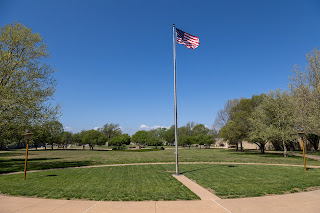This is a special edition of my Wanderlusting Blog is to reassure you that we are okay and are doing whatever we can to remain safe in our home on wheels. We had a close call yesterday by missing the tornado in Omaha by less than 24 hours. The weather remains unsettled, but the campground has emergency plans and facilities available if necessary. However, I am reassessing how, when, and where we will travel. But I would like your help. In the meantime, rest assured that safety remains our top priority, and I will keep posting on FB as the needs arise.
 |
| Chappell Hill, Texas 3/2024 |
 | ||
| Gretna, Nebraska 4/24 |
These are shots of two of our campsites this Spring. The first is from our stay in Chappell Hill, Texas, where we just missed a tornado in the storm on the horizon. We barely missed the tornado that struck Bellville, Texas, an hour after we passed through. The second is from our lovely campsite in Gretna, Nebraska, just outside Omaha. The dark clouds on the horizon are a severe thunderstorm whose leading edge is about 5 miles away. This storm produced large hail and tornados in SE Nebraska, NE Kansas, and Northwest Missouri. It was the second time we dodged a severe Thunderstorm that produced a tornado, damaging hail, and high winds. In both instances, we had left our previous campsite early to avoid driving through those areas during the storm. These count as close calls. Unfortunately, they have become weekly occurrences since leaving the Rio Grande Valley on the first of March. These experiences have been nerve-wracking, to say the least, and have made us reconsider our travel planning.
Those following us over the last 21 months know that two of my goals are to chase 70 degrees and avoid hurricanes along the Gulf Coast. We have lived in areas where winter arrived in October and left in April. I have evacuated from hurricanes and helped clean up after several more. In short, I have developed a deep desire to limit my exposure to terrible weather. However, this desire has been made more difficult to fulfill due to human-influenced global warming.
This year, I did not count on a jet stream that would dip into the SW and stay there. This generally happens every Spring. Typically, high-pressure domes move in and push the jet stream East by mid to late Spring. But this year, it has continued to pump warm, moist air up from the Gulf of Mexico, spawning weekly storm systems that stretch from Texas to Illinois and wreak havoc on the Midwest. I have watched these systems for years and was willing to risk a month or so on this expected weather pattern. But, in talking with locals from Texas to Nebraska, I am told repeatedly that this year had been exceptionally wet, windy, and prone to large, dangerous storms.
Those who followed us last year will also remember a similar situation when we traveled through California. Last Spring, the "Atmospheric Rivers" wiped out our hopes of visiting the National Parks in Southern California. Yosemite, King’s Canyon, Lassen Volcano, and Sequoia were all closed while we were in the area. Crater Lake was closed by a landslide. We diverted to HWY 101 and had a good time, but we will have those parks on our bucket list for next year. We had to divert through Salt Lake City on the return because Death Valley was closed due to a Hurricane. I can plan all I want and include the weather factor in the process, but there is no way to account for the human-caused changes to our weather patterns. We are all on new ground, especially the National Weather Service. These extraordinary events are becoming far too ordinary, so I must adjust my strategy.
First, I need to examine my travel goals, considering this new information about the weather. I need to account for temperature, winds, and precipitation, knowing that the last two are highly unpredictable.
Second, reliable sources of information about climate forecasts for North America need to be found. I recognize that these could be more precise. Still, I need to find a source that looks at trends and can offer meaningful insights into the weather variables.
Third, I need to begin looking at routing our trips with more reliable new information. Currently, I have been using a rule of thumb, allowing a 20% temperature variation in route planning based on climate data from the National Weather Service. Now I need to find a resource for rain and wind as well. If you know of any sources, please leave me a comment on this blog entry. I am considering using www.weather.gov, more extensively but I'm open to other suggestions.
In a conversation with a friend who has lived in the Midwest for most of his life, these storms are just part of living here. To my mind, this is an excellent reason to stay on the road. Every area of the country has its weather challenges. There are spring storms in the Midwest and Southeast, Spring and Summer hurricanes along the Gulf Coast, extreme Summer heat in the Desert Southwest, late and early snow storms in the mountains, and Nor'easters in New England. So, I think the best way to enjoy good weather is to stay on the move. But I need better information to plan our travels. Safety remains our first and foremost goal; these new weather challenges mean we must change our planning.
I look forward to your comments and suggestions. We will continue wandering and look forward to your traveling with us. Your insights could be invaluable in helping us navigate these weather challenges. I will carefully consider each suggestion and update you on how we plan to incorporate them into our future travels.
Be safe, my friends!
Bob
(Please share your comments and suggestions.)


















































































































